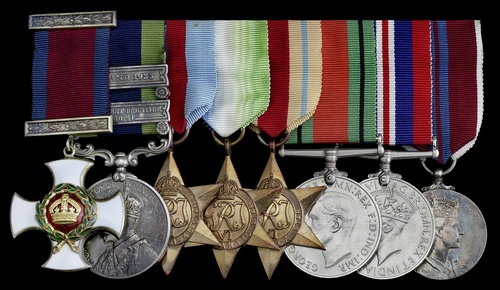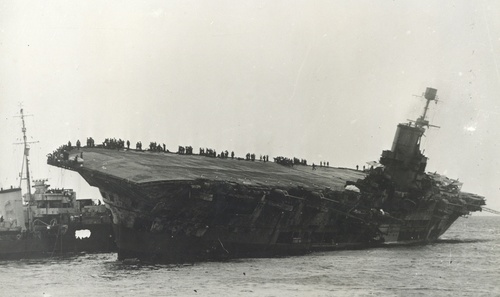Auction: 18003 - Orders, Decorations and Medals
Lot: 566
An outstanding - and excessively rare - Fleet Air Arm Squadron C.O.'s Malta convoy D.S.O. group of eight awarded to Commander J. Sholto Douglas, Royal Navy, late Royal Air Force
A pre-war pilot in the R.A.F., who witnessed active service on the North-West Frontier and in the Mohmand operations of 1933, he transferred to the Fleet Air Arm on the eve of the renewal of hostilities
Appointed to the command of No. 807 Squadron in September 1940, he went on to serve with the distinction aboard the carrier Ark Royal - from April 1941 up until her subsequent loss off Gibraltar - a period of operations encompassing the famous Bismarck action and crucial Malta convoy work
During one such convoy on 23 July 1941 - Operation "Substance" - Sholto Douglas claimed a 'probable' S. 79 and damaged another but was himself hit and compelled to ditch in the sea. It was but one chapter in a heavily contested passage to Malta, a chapter in which the Fleet Air Arm gained wide approbation: a fellow pilot operating from the 'Ark' - Lieutenant (A.) A. T. J. Kindersley, R.N. - was recommended for a posthumous V.C. in the same operations
Distinguished Service Order, G.VI.R., silver-gilt and enamel, the reverse of the suspension bar officially dated '1941'; India General Service 1908-35, 2 clasps, North West Frontier 1930-31, Mohmand 1933 (F./O. J. S. Douglas, R.A.F.); 1939-45 Star; Atlantic Star; Africa Star; Defence and War Medals 1939-45; Coronation 1953, mounted as worn, together with F.A.A. uniform bullion 'Wings' (3), generally good very fine (11)
D.S.O. London Gazette 25 November 1941:
'For courage and resolution in Mediterranean waters.'
The original recommendation states:
'He repeatedly - and by himself - attacked a formation of five S. 79 aircraft, probably shooting down one and damaging another, which dropped from the formation and was finally shot down by another Fulmar.
He carried out seven attacks on the enemy, forcing some of them to jettison their bombs. Eventually his own aircraft was damaged and he was forced to break off and to land in the sea.'
James Sholto Douglas, a scion of the famous Douglas family of Morton Castle in Dumfries - today the property of the Duke of Buccleuch - entered the Royal Air Force as a Cadet in the mid-1920s and was commissioned Pilot Officer in December 1928.
Advanced to Flying Officer in July 1930, he was posted to No. 20 Squadron and quickly witnessed active service on the North-West Frontier, operating in Wapitis out of Peshawar; the Squadron's O.R.B. bears testament to a constant flurry of sorties, both of a reconnaissance and bombing nature, and notes resultant damage sustained by rebel rifle fire. Two years later, Sholto Douglas was back in action during the Mohmand operations of 1933: he thereby became one of just six R.A.F. officers to qualify for this combination of clasps.
Having then gained advancement to Flight Lieutenant in late 1937, he transferred to the Fleet Air Arm in February 1939 and joined No. 822 Torpedo Squadron in the carrier H.M.S. Courageous.
Naval Wings
In September 1940, in the rank of Lieutenant-Commander, Sholto Douglas assumed command of No. 807 Squadron, and he remained actively employed in the same capacity until November 1941.
The newly formed squadron - motto 'Ready To Strike In All Directions' - was equipped with Fairy Fulmars and initially joined H.M.S. Pegasus for catapult fighter duties in early 1941. It subsequently transferred to the Furious on convoy duties and, in April 1941, after re-equipping with Fulmar IIs, it joined Ark Royal for Malta convoy duties. Sholto Douglas's tenure of command in the period leading up to Ark Royal's loss in November 1941 was marked by considerable action, not least in Operations "Substance" and "Halberd" in July and September, during which 15 enemy aircraft were destroyed, another probably destroyed and four others damaged.
Operation "Tiger"
First up, however, was 807's part in Operation "Tiger" in May 1941, when Ark Royal accompanied a convoy supported by ships from Force 'H' from Gibraltar to Alexandria. Two days after departing the Rock, on 8 May, the convoy came under sustained attack. Sholto Douglas - with Petty Officer Nuttall as his Observer - led 807's Red section into the fray and shot-up two Me. 110s, one of which was seen to go down in the clouds. He, in turn, received hits on the leading edges of his Fulmar's mainplanes and in the hydraulic system.
Over the course of the day, 12 of Ark Royal's Fulmars - the maximum number available - drove off over 50 enemy aircraft. One Fulmar was lost with its crew during the initial attack; another was destroyed but the aircrew recovered, while several others were damaged. Consequently, only seven were able to face the main Luftwaffe force of 34 aircraft, while an attack just before dark was driven off by two aircraft and heavy fire from the ships. The convoy survived without serious damage but Ark Royal underwent another aerial attack on 12 May, during her return to Gibraltar.
Later in May - in Operation "Splice" - she and her fellow carrier Furious undertook a vital mission to deliver Hurricanes to Malta. In total 48 aircraft were flown off the two carriers on the 21st and all of them safely reached their destination.
Later still, at the end of the month, the 'Ark' was called away in pursuit of the Bismarck. Her part in that memorable operation -and that of her gallant aircrew - proved to be crucial, one of her Swordfish inflicting a fatal wound on the enemy battleship. Although the Fulmars of 807 Squadron were not called to action, Sholto Douglas no doubt shared in the trials and tribulations of his fellow F.A.A. aircrew.
Operation "Substance" - immediate D.S.O.
In July 1941, Sholto Douglas and his aircrew faced further strife, Ark Royal having been assigned to the defence of another crucial Malta convoy, codenamed Operation "Substance". Once more in the company of Force 'H', Ark Royal departed Gibraltar at 0340 hours on the 21st, some 70 minutes late due to a low-lying fog. On Wednesday the 23rd, as the convoy sailed south of Sardinia, the Regia Aeronautica and Luftwaffe commenced a spate of determined attacks. Ark Royal's captain's report states:
'R.D.F. reports at 0914 hours started giving notice of a large formation approaching from the north-east, working round to the eastward, so at 0927 hours more fighters were flown off. A high-level bombing attack from 12,000 feet developed which was successfully intercepted by our fighters about 22' off. The enemy consisted of S. 79s in two formations, one of five and one of four, and all our fighters got in their attacks, Lieutenant-Commander [Sholto] Douglas leading the first attack, Lieutenant Hallett the next, a head-on attack, and Lieutenant Lewin beam and quarter attacks. As a result of these attacks two enemy aircraft were shot down definitely and one probably, with at least one other damaged … casualties to our own aircraft in the battle with the bombers were three shot down, but the crews were rescued. Another fighter crashed into the barrier on returning to land-on.'
In a separate onslaught, synchronised with the above attack, seven Italian bombers came in low and inflicted significant damage on the cruiser Manchester and the destroyer Fearless. The former had to turn for Gibraltar and the latter - at length - was evacuated and sunk by our own gunfire. Yet the gallant actions of Sholto Douglas and his fellow Fulmar aircrew in 807 Squadron allowed the convoy to reach the Skerki Channel by late afternoon.
As confirmed by the recommendation for his immediate D.S.O., Sholto Douglas carried out seven attacks on the enemy formation and himself probably accounted for one of the S. 79s, in addition to damaging another; the latter dropped away from its formation and was finished off by Lieutenant (A.) N. G. Hallett. But with his own aircraft hit and badly damaged by return fire, Sholto Douglas had to undertake the unenvious task of enacting a ditching in the sea. He emerged unscathed and was fortunate to be picked-up.
The Fulmars of 807 Squadron were back in action on the 25th, operating alongside their comrades in 808 Squadron. By close of play the combined strength of the squadrons was reduced to 12 serviceable aircraft; the loss in personnel amounted to two Fulmar crews, another four crews having been rescued from the drink. Among the lost was Lieutenant Alistair Kindersley, R.N., who had flown in the Battle of Britain, and his T.A.G., Acting Petty Officer (A.) Frederick Barnes. Kindersley was recommended for a posthumous V.C. but the Second Sea Lord reduced the award to a mention in despatches.
Loss of the 'Ark'
Having in the interim lent equally valuable service during Operation "Halberd" in September - the last convoy to reach Malta that year - Sholto Douglas was still serving aboard the 'Ark' at the time of her loss on 10 November 1941. On that date the carrier was returning to Gibraltar after delivering further aircraft to Malta, when, at 1540 hours, she was struck amidships by a torpedo delivered by the U-81. The explosion caused Ark Royal to shake, hurled loaded torpedo-bombers into the air and killed Able Seaman Edward Mitchell. The resultant 130-by-30-foot hole in the ship's starboard side and keel proved fatal.
Immediately after the torpedo strike, Captain Maund ordered the engines to full stop, but discovered that communications were down and had to send a runner to the engine room. The ship's continued motion enlarged the hole in the hull, and by the time Ark Royal stopped she had taken on a great deal of water and begun to list to starboard, reaching 18° from centre within 20 minutes.
Given the previous fate of the carriers Courageous and Glorious, which had both sunk rapidly with heavy loss of life, Maund gave the order to abandon ship. The crew were assembled on the flight deck to determine who would remain on board to try to save the ship while Legion came alongside to take off the rest. As a result, comprehensive damage control measures were not initiated until 49 minutes after the attack; the flooding spread unchecked, exacerbated by covers and hatches left open during evacuation of the lower decks.
Subsequent attempts to take the carrier in tow and save her failed, her list eventually reaching 27°. By 0430 hours her complement had been evacuated to Legion and, with the exception of Mitchell, there were no further fatalities. The 1,487 officers and crew were transported to Gibraltar.
The carrier's list eventually reached 45° and she capsized and sank at 0619 hours on 14 November. Witnesses reported the ship rolling to 90°, where she remained for three minutes before inverting. Ark Royal then broke in two, the aft sinking within a couple of minutes, followed by the bow.
Subsequent career
Sholto Douglas's much depleted command next joined the carrier Argus at Gibraltar, from whence it carried out numerous recce. flights over Casablanca, Cape Santa Maria and Malilla; he was compelled to make a forced-landing in his Fulmar at Cluminzata in neutral Portugal in November 1941; he and his observer - Lieutenant (A.) A. Greogory, R.N. - were briefly interned.
Having been promoted to Commander (A.) in June 1942, Sholto Douglas was appointed C.O. to a succession of R.N.A.S. bases, namely Gannet in May 1943, Goldcrest, in August 1946, Falcon in Malta in December 1948 and Merlin in October 1950. His final appointment was with the Naval Air Warfare Division at the Admiralty in the early 1950s. The Commander died in November 1981.
Please see Lot 782 for the recipient's miniature dress medals.
Subject to 20% VAT on Buyer’s Premium. For more information please view Terms and Conditions for Buyers.
Sold for
£3,500







